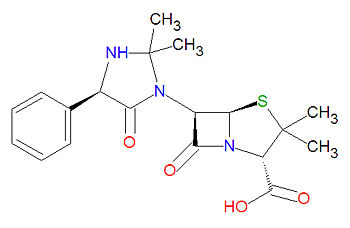Hetacillin: Difference between revisions
imported>David E. Volk (stub and structure, more to follow tomorrow) |
imported>David E. Volk No edit summary |
||
| Line 2: | Line 2: | ||
[[Image:Hetacilliln structure.jpg|right|thumb|350px|{{#ifexist:Template:Hetacilliln structure.jpg/credit|{{Hetacilliln structure.jpg/credit}}<br/>|}}Hetacillin]] | [[Image:Hetacilliln structure.jpg|right|thumb|350px|{{#ifexist:Template:Hetacilliln structure.jpg/credit|{{Hetacilliln structure.jpg/credit}}<br/>|}}Hetacillin]] | ||
'''Hetacillin''' is a [[penicillin]]-like, beta-[[lactam]] based [[antibiotic]] | '''Hetacillin''' is a [[penicillin]]-like, beta-[[lactam]] based [[antibiotic]] prodrug used to treat infections, usually from [[gram-positive]] bacteria. | ||
== Mechanism of action == | |||
Hetacillin is a prodrug with no antibacterial activity, but it is metabolized into the antibiotic [[ampicillin]]. Hetacillin is prepared by reacting ampicillin with acetone because ampicillin is much less stable towards ring-opening reactions. Once converted to ampicillin, the ampicillin interferes with the final stage of cell wall synthesis by binding to penicillin-binding proteins, leading to [[autolysis]] of the bacteria by [[autolysin]] enzymes. | |||
== Chemistry == | |||
It is a beta-[[lactam]] structure, and its chemical name is (2S,5R,6R)-6-[(4R)-2,2-dimethyl-5-oxo-4-phenylimidazolidin-1-yl]-3,3-dimethyl-7-oxo-4-thia-1-azabicyclo[3.2.0]heptane-2-carboxylic acid. Its chemical formula is C<sub>19</sub>H<sub>23</sub>N<sub>3</sub>O<sub>4</sub>S (MW = 389.4686 g/mol). | |||
== External links == | |||
* {{DailyMed}} | |||
* Drug Bank [http://www.drugbank.ca/cgi-bin/getCard.cgi?CARD=DB00739.txt] | |||
Revision as of 18:00, 12 February 2008
Hetacillin is a penicillin-like, beta-lactam based antibiotic prodrug used to treat infections, usually from gram-positive bacteria.
Mechanism of action
Hetacillin is a prodrug with no antibacterial activity, but it is metabolized into the antibiotic ampicillin. Hetacillin is prepared by reacting ampicillin with acetone because ampicillin is much less stable towards ring-opening reactions. Once converted to ampicillin, the ampicillin interferes with the final stage of cell wall synthesis by binding to penicillin-binding proteins, leading to autolysis of the bacteria by autolysin enzymes.
Chemistry
It is a beta-lactam structure, and its chemical name is (2S,5R,6R)-6-[(4R)-2,2-dimethyl-5-oxo-4-phenylimidazolidin-1-yl]-3,3-dimethyl-7-oxo-4-thia-1-azabicyclo[3.2.0]heptane-2-carboxylic acid. Its chemical formula is C19H23N3O4S (MW = 389.4686 g/mol).
External links
- Hetacillin - FDA approved drug information (drug label) from DailyMed (U.S. National Library of Medicine).
- Drug Bank [1]
